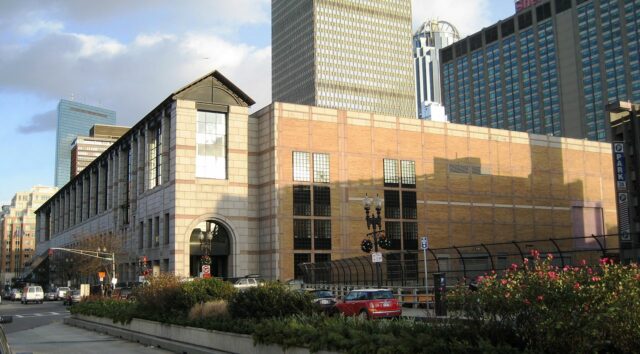Like a hoarder whose possessions no longer spark joy, Gov. Charlie Baker wanted to put Massachusetts on a real estate diet.
With state agencies owning more than 20,000 parcels spanning 575,000 acres, Baker fretted about lost opportunities to create jobs and housing. His “Open for Business” program set an ambitious goal of selling vacant and underutilized properties from Boston to Belchertown and beyond.
“People call a lot of land we own ‘assets,’ but they’re not a source of income,” Baker told a commercial real estate gathering in 2016. “A lot of it is located in pretty interesting places. This has the potential to unlock hundreds of millions over time in economic activity.”
But sometimes, nobody wants your second-hand treasures. The first centerpiece of Baker’s “Open for Business” initiative offered up nearly 5 acres on the edge of Boston’s Chinatown, but potential developers balked at the minimum $167 million price tag and requirement to relocate a steam plant located on the Kneeland Street property. Not a single firm submitted a proposal when the Massachusetts Department of Transportation offered it for sale in 2017.
More recently, a decade-long attempt to build an $800 million condo tower above the Massachusetts Turnpike in Back Bay collapsed amid a financial stalemate between MassDOT’s chosen developer, Boston-based Weiner Ventures, and construction giant Suffolk. MassDOT canceled the parcel 15 air rights development in October.
Now the administration is taking another crack at marquee real estate dispositions, seeking private proposals to redevelop the 5.6-acre the Hynes Convention Center property in Back Bay and the Charles F. Hurley state office building in the West End.
New Offers Hold More Promise
Both properties are in prime locations near growing development clusters, and real estate executives predict they’ll receive a warmer reception.
“When you think about Back Bay from a demand standpoint, you have the highest-renting office submarket, the highest-renting apartment submarket and the highest-renting retail market in the city of Boston,” said Ben Sayles, a senior director at JLL Boston. “And these strong and diverse demand drivers will enable multiple reuses for the [Hynes] site.”
Historic preservation guidelines could complicate the Hurley building redevelopment, a risk factor acknowledged by state officials as they prepared to seek offers.
The over Hynes property sits near several high-profile development sites, including the recently completed One Dalton uber-luxury condo tower and Samuels & Assoc.’s parcel 12 air rights project, which includes an office tower that could break ground in early 2020.
The Hurley building is steps from HYM Investment Group’s Bulfinch Crossing, where the 45-story Sudbury residential tower is nearing completion and a new State Street Corp. headquarters will occupy half of a 1 million-square-foot office tower that broke ground in June.
Both the Hynes and Hurley properties could support large-scale projects, potentially prompting developers to pay the state hundreds of millions in lease or sale payments. The Hurley site is zoned for buildings ranging from 125 to 400 feet, according to state officials.
“With the strong economy we have right now, it’s a great time to hit the market,” said David Begelfer, principal at CRE Strategic Advisors and a former CEO of NAIOP-Massachusetts. “A better time would have been a year ago, but this is still a good time to do it.”

The Baker administration is seeking legislative approval to sell Back Bay’s Hynes Convention Center, and real estate executives predict it will attract strong interest from office, hotel and residential developers. Photo courtesy of Grk1011 / CC BY-SA 3.0
State Points to Wins
The Baker administration announced in 2016 that it had identified 42 properties that it would market to private developers under the Open for Business program. A complete list of how many have been sold since then was not available from the administration. But Patrick Marvin, spokesman for the Executive Office for Administration and Finance, pointed to three examples of the program’s progress.
In 2018, the state Division of Capital Asset Management and Maintenance (DCAMM) deeded the former Salem Superior Courthouse to the city’s redevelopment authority. In September, developers Urban Spaces and Diamond Sinacori broke ground on a 61-unit condo complex called BRIX.
DCAMM recently sought proposals for 10 acres in the next phase of the Boston State Hospital property redevelopment in Mattapan. And Massport is seeking proposals for its latest real estate venture in the Seaport District, on a parking lot next to 601 Congress St. known as parcel H.
“It’s important to note that in any given transaction, the process from project identification to disposition to redevelopment often takes several years and is dependent upon other entities such as municipal partners who assume responsibility for development,” Marvin said in an emailed statement.
The Paradox of State-Owned Real Estate
The state’s mixed track record reflects the paradox of monetizing its real estate, Begelfer said.
“Every administration would like to see some projects move forward on surplus property. The problem is: a lot of the properties that are surplus are in locations that are challenged,” he said.
Both the Hurley and Hynes sites face potential political and permitting hurdles. The proposed Hynes sale requires legislative approval as part of a proposed $500 million expansion of the Boston Convention and Exhibition Center in the Seaport, with proceeds going toward the BCEC project.
Historic preservation guidelines could complicate the Hurley building redevelopment, a risk factor acknowledged by state officials as they prepare to seek offers.
The administration has reached out to groups including the Boston Preservation Alliance, seeking to head off a showdown before the Massachusetts Historical Commission. The 327,000-square-foot Hurley building which fronts on Cambridge Street connects to the Lindemann Mental Health Center, a Brutalist edifice on Staniford Street designed by prominent modernist architect Paul Rudolph. The building is included in the Massachusetts Historical Commission’s inventory of historic assets.

Steve Adams
The complex, known collectively as the Boston Government Service Center, is “among the most dramatic and architecturally ambitious of the modern office structures built as part of the Government Center urban renewal project of the 1960s and ’70s,” according to Boston Landmarks Commission documents.
Informational materials released by DCAMM this month state that the redevelopment “will acknowledge the architecturally significant elements of the Hurley-Lindemann site, while addressing its flaws.”
“They’ve assured us part of the goal is to develop some revenue so they can repair the Lindemann building, and they recognize that is a historically important piece of architecture,” said Greg Galer, executive director of the Boston Preservation Alliance.




 |
| 


